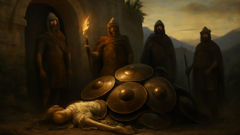Introduction
High atop the rugged cliffs of Rome, where the city’s ancient heart still beats in the shadow of crumbling walls and wild olive trees, the Tarpeian Rock stands as both a monument and a warning. It is not just a place, but a presence—etched into the collective memory of a people who built an empire from earth, sweat, and sometimes, betrayal. On those stony heights, the air is crisp and laced with the scent of cypress. The wind whistles through cracks in the tufa, carrying whispers of old Rome—of the Sabines and the Romans, of kings and warriors, and of a young woman whose ambition would change the fate of her city forever. Her name is Tarpeia, daughter of the Roman commander Spurius Tarpeius. In the earliest days of Rome, when the city was still little more than a cluster of huts rising from the Palatine, alliances were fragile, and the line between friend and foe could vanish overnight. The Sabines, neighbors and rivals, coveted Rome’s promise. Within the walls, Tarpeia walked, bright-eyed and restless, yearning for something beyond the narrow confines of duty and expectation. But even as Rome braced for siege, as shields gleamed in the morning sun and swords were sharpened for battle, Tarpeia’s heart turned not to her city’s defense, but to her own secret desires. Her story is not one of simple treachery, but of longing, misjudgment, and the heavy hand of justice. As we journey into this legend, let the shadow of the Tarpeian Rock remind us that every stone in Rome has been stained, in some way, by the ambitions and failings of those who came before.
The Siege of Rome and the Birth of Ambition
In the dawn of Rome’s history, before marble temples and legions marching in formation, the city was little more than a fortified hilltop. It rose from the mud and stones, hemmed in by forests and wild rivers, with the Tiber curling like a silver ribbon in the valley below. The Romans were a people forged in adversity—descendants of refugees, shepherds, and outcasts, all bound by the dream of belonging. Their city was young and brash, its defenses still raw against the world’s dangers.

It was in this tense and brittle time that the Sabines came. They were Rome’s neighbors, yet also its rivals—a proud, warlike tribe who resented Rome’s growing strength. The Sabines descended from the highlands, their spears gleaming, their horses restless. They laid siege to the fledgling city, encamping in the woods beyond the walls. At the heart of the Roman defenses stood the citadel atop the Capitoline Hill, guarded day and night by the most trusted soldiers—among them Spurius Tarpeius, who commanded with stern devotion. His daughter, Tarpeia, lived within these walls.
Tarpeia was not like other Roman maidens. Where her peers were content with weaving and prayers to Vesta, Tarpeia watched the soldiers drill in the courtyards, her mind churning with questions. Her eyes were drawn not only to their strength but to the golden bracelets and jeweled armbands that flashed upon the Sabines’ arms as they parleyed at the gates. Wealth was a rare sight in Rome, and such trinkets seemed to her more precious than the simple coin of her homeland. Tarpeia’s mother had died young, and her father, though kind in his way, was distant—his affection buried beneath armor and duty. Tarpeia grew up wandering the shadowed halls of the citadel, a solitary figure lost among ancient stones and echoing footsteps. She learned the city’s secrets: the hidden stairways, the patterns of the guards’ patrols, the narrow postern gates that opened only at night.
As the siege dragged on, food grew scarce. The city’s markets emptied, and children learned hunger. At night, fires flickered atop the walls as sentries kept watch for Sabine raiding parties. Tarpeia watched from her high window, a growing bitterness twisting inside her. Why should she suffer for Rome’s pride? Why must she be denied the beauty and wealth she saw dangling from the arms of her enemies? It was during these long, hungry nights that ambition took root in her heart. The Sabines, she reasoned, were not so different from the Romans. They too had daughters, mothers, lovers—people who wept for them when they fell. The difference was that the Sabines offered a promise: wealth beyond measure, freedom from the grinding struggle of daily life.
One evening, as dusk softened the edges of the city and the watchfires burned low, Tarpeia made her way to a narrow postern gate she had often spied from afar. It led through a thicket of laurel at the base of the Capitoline. With a hood drawn over her dark hair and a cloak to hide her face, she slipped into the night, her heart pounding in her chest. She made her way down a secret path—one worn by centuries of footfalls, yet deserted in the uneasy quiet of siege. The Sabine camp was close, its tents like pale mushrooms in the moonlight. Torches sputtered and sentries muttered in their harsh dialect. Tarpeia hid among the trees, waiting for a sign.
She did not have to wait long. Tatius, king of the Sabines, rode out from the camp with his captains. He was a man of presence—broad-shouldered, bearded, with eyes that glinted like hammered iron. Tarpeia stepped from the shadows and called out, her voice trembling but resolute. The Sabines seized her, dragging her before Tatius. They expected a spy or a supplicant; instead, they found a young woman whose gaze was steady despite her fear.
“I am Tarpeia,” she said. “Daughter of the Roman commander. I can open the citadel for you.”
The Sabines scoffed. “And what do you want for this betrayal?” Tatius asked, his tone sharp.
Tarpeia looked at the gold and jewelry flashing on their arms. “Give me what you wear on your left arms,” she answered, thinking of their bracelets and armbands.
Tatius exchanged glances with his captains. In the flickering torchlight, they smiled—not kindly, but with a cold cunning that Tarpeia did not see. Tatius nodded. “If you do as you promise, you shall have what we wear on our left arms.”
As she slipped back through the woods, Tarpeia’s heart leapt. Her mind spun with visions of gold and jewels, of a life freed from hunger and obscurity. She did not know that her words—so carefully chosen—would seal her fate.
Betrayal and Retribution on the Capitoline
Night fell heavy on Rome as Tarpeia returned to the citadel. She moved through the silent corridors like a ghost, every echo of her footsteps a reminder that she no longer belonged wholly to her city. Her mind reeled with guilt and anticipation—would the Sabines honor their promise? Would Rome forgive her, or would her name be lost beneath the stones she now crossed?

She waited for midnight, when the city’s defenders would be most weary. The postern gate at the base of the hill was guarded by a single sentry—an old man who remembered Tarpeia as a child and gave her a nod as she passed. With practiced ease, she unlocked the heavy iron bolt and swung the gate open. Down in the darkness below, she saw torchlight flicker—the Sabines were waiting. Her heart thundered, torn between fear and excitement. She beckoned, signaling as arranged.
The Sabines moved with silent precision. Warriors crept up the narrow path, their shields slung over their left arms, their faces painted with war symbols. They climbed, step by step, toward the sleeping city above. Tarpeia kept her place by the open gate, shivering in the cold night air. She could smell the oil and leather of the Sabines’ armor, hear their whispers as they passed. One by one, they slipped into the citadel, their numbers growing, until at last King Tatius himself appeared at the threshold.
Tatius regarded Tarpeia with something like pity—or perhaps contempt. She stretched out her hands, eager for the reward she had been promised. The king raised his arm, displaying the heavy shield strapped to it. For a single heartbeat, Tarpeia’s eyes widened as she realized her mistake. The Sabines wore not only golden bracelets on their left arms, but also their shields—broad, heavy, edged in iron.
Without a word, Tatius gave the signal. One after another, the Sabine warriors hurled their shields upon Tarpeia, crushing her beneath their weight. Her scream was muffled by bronze and wood, her ambition extinguished as quickly as it had flared. The Sabines stood over her broken body in silence—a grim offering to the gods for her treachery.
With the citadel breached, the Sabines surged into Rome. But their victory was brief; Roman defenders, roused by the commotion, mounted a desperate resistance. The city became a battleground of torchlight and shadow, of shouted orders and clashing swords. Through it all, Tarpeia’s body lay at the threshold—a caution to all who might seek profit from betrayal.
When dawn broke, the Romans found her crushed beneath a mound of shields, her face barely visible among the battered metal and splintered wood. The people of Rome wept—not for Tarpeia, but for what her actions had brought upon them. Her father, Spurius Tarpeius, knelt beside her lifeless form and felt the cold weight of shame. He ordered her body buried at the very place where she had fallen—at the edge of the cliff that would bear her name forevermore: the Tarpeian Rock.
In the days that followed, the Romans drove out the Sabines through sheer desperation and unity. Yet the cost was great. The legend of Tarpeia spread like wildfire—her name became a curse whispered by mothers to their daughters. No longer just a maiden, she became a symbol: of ambition unchecked, of trust betrayed, and of justice meted out by fate itself.
Legacy of the Rock: Memory and Meaning
Years passed, but the shadow of Tarpeia’s deed never faded from Rome. The Tarpeian Rock became more than just a promontory overlooking the Forum; it became a place of judgment. Condemned traitors were led to its edge and cast down upon the stones below—each fall a reminder that treachery was met not with mercy, but with swift and public justice. The city’s children grew up reciting Tarpeia’s name as a warning; artists painted her story on clay urns and temple walls, her face always etched in sorrow or horror.

Yet not all saw her in black and white. As time softened the sharpness of memory, philosophers and poets began to debate her legacy. Was Tarpeia truly evil—a monster driven by greed? Or was she a tragic figure, undone by longing and loneliness? Some claimed she was lured by Sabine cunning; others said she had tried to broker peace and been misunderstood. Still others whispered that she had loved a Sabine warrior and acted out of doomed passion. Each telling added layers to her myth, but none could erase the cold fact: Rome would never again trust so easily.
The Tarpeian Rock itself became sacred and feared. During triumphs, victorious generals would parade past it—reminded that fortune could turn with a single step. Prisoners doomed for betrayal would pause at its edge, looking down at the jagged stones and remembering Tarpeia’s fall. The rock served as both an execution ground and a symbol—a place where Rome’s values were enforced not by words, but by action.
For Tarpeia’s father, life went on, but it was never the same. He retired from his command and lived out his days tending a small shrine at the base of the hill—a place where offerings could be left for his daughter’s restless spirit. Some said they saw her ghost wandering the cliffs at night, her hair unbound and her arms reaching for something just out of reach: forgiveness, or perhaps the gleam of gold that had cost her everything.
And yet, in a strange way, Tarpeia’s story gave Rome its strength. The city learned to guard its secrets more closely, to test the loyalty of its people, and to punish betrayal with unflinching resolve. The legend of the Tarpeian Rock was woven into Roman law and custom, shaping how generations thought about honor and justice. To this day, if you climb to the heights above Rome and stand where the wind tugs at your cloak, you can almost hear the echoes of that ancient night—the clatter of shields, the hurried breaths of traitor and king, and the solemn silence that follows when ambition meets its end.
Conclusion
The legend of the Tarpeian Rock endures not just because it marks a place on Rome’s map, but because it maps something deeper in the human soul—a warning about the cost of ambition and the inescapable reach of justice. Tarpeia’s story is not easily dismissed or forgotten. It lingers in the language of law, in the architecture of punishment, and in every tale told to remind children and rulers alike that trust once broken can never be wholly repaired. For Rome, the rock became a silent arbiter, standing as a testament to what happens when loyalty falters and personal desire eclipses duty. Yet even in her infamy, Tarpeia remains a figure we cannot help but pity—her longing as human as her fall was catastrophic. To stand atop the Tarpeian Rock today is to feel the weight of centuries pressing close: the breathless hush before betrayal is revealed, the clangor of shields in the night, and finally, the hush that follows when justice has been done. In that silence, we remember not just a maiden’s downfall, but the hard-earned lesson that every choice—however small—can echo for ages. The city may have survived her betrayal, but it was changed forever by her story. And so, as the sun sets over Rome and the stones cool beneath the stars, the Tarpeian Rock waits—ever watchful, ever warning.


















